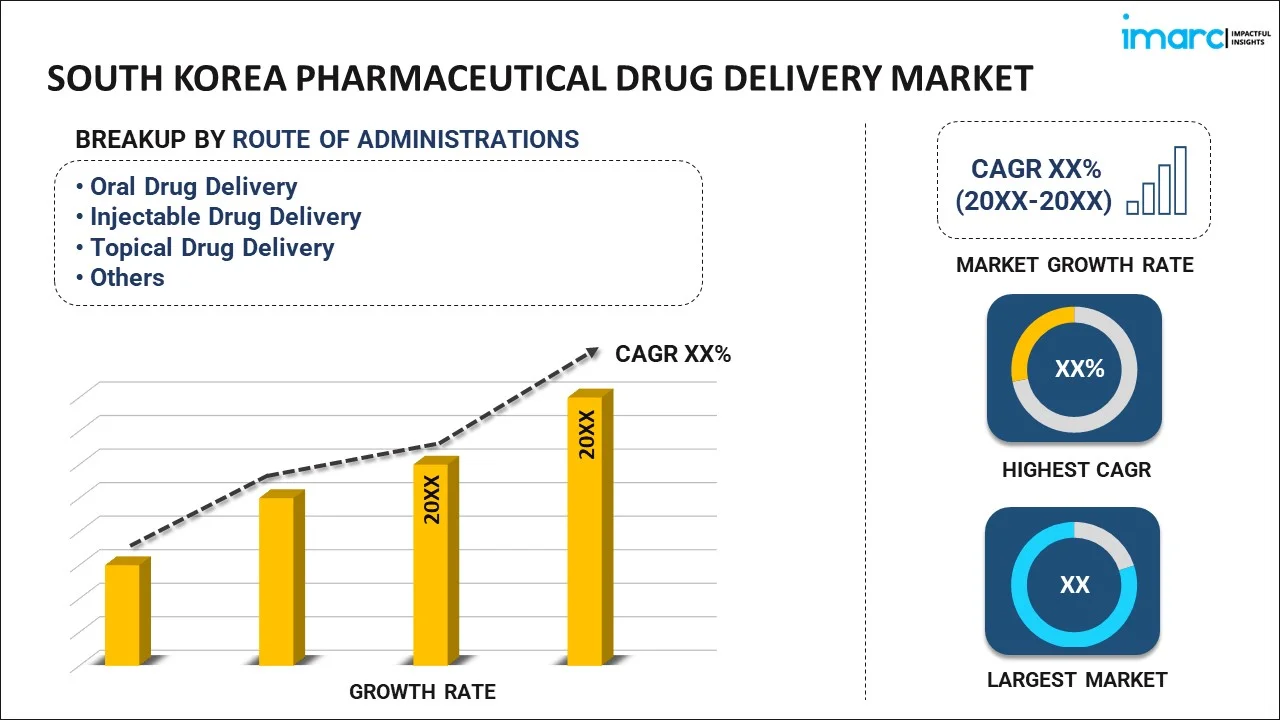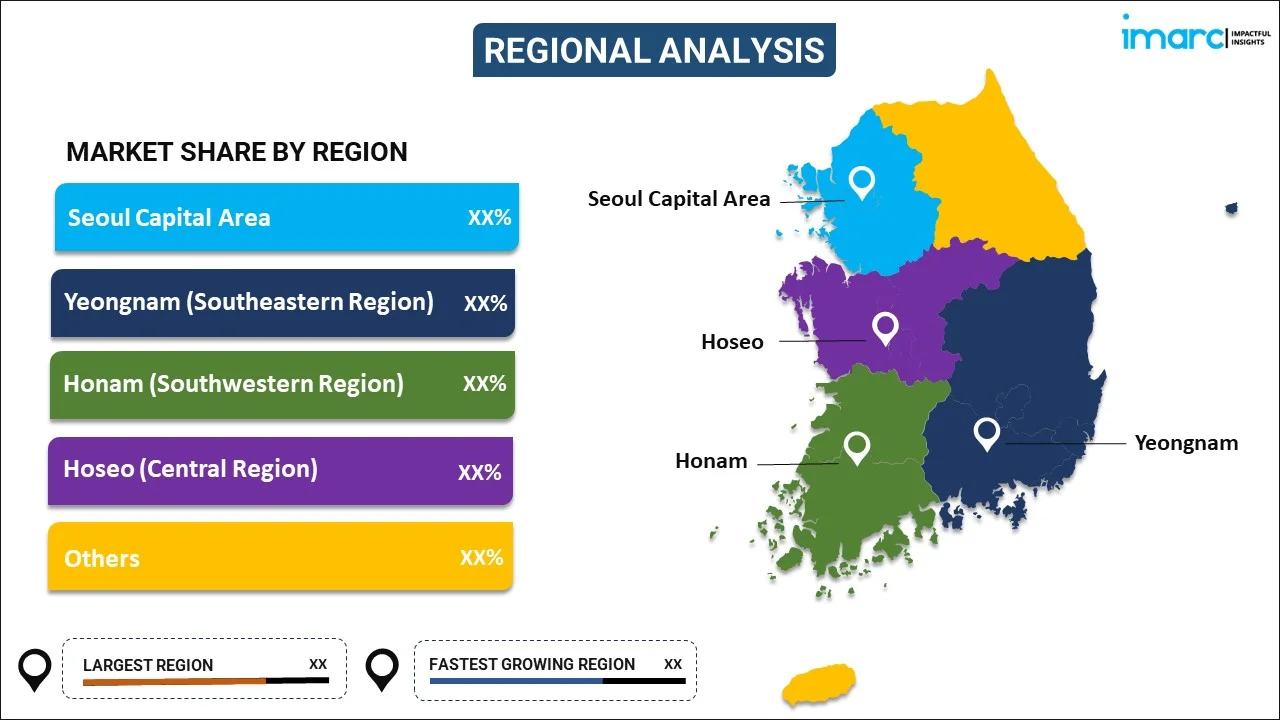
South Korea Pharmaceutical Drug Delivery Market Report by Route of Administration (Oral Drug Delivery, Injectable Drug Delivery, Topical Drug Delivery, Ocular Drug Delivery, Pulmonary Drug Delivery, Implantable Drug Delivery, Transmucosal Drug Delivery, Nasal Drug Delivery), Application (Infectious Diseases, Cancer, Cardiovascular Diseases, Diabetes, Respiratory Diseases, Central Nervous System Disorders, Autoimmune Diseases, and Others), End User (Hospitals, Ambulatory Surgery Centers, Home Care Settings, Diagnostic Centers, and Others), and Region 2024-2032
Market Overview:
The South Korea pharmaceutical drug delivery market size reached US$ 11.74 Billion in 2023. Looking forward, IMARC Group expects the market to reach US$ 25.94 Billion by 2032, exhibiting a growth rate (CAGR) of 8.10% during 2024-2032. The rising healthcare expenditure, growing pharmaceutical industry, increasing chronic diseases, patient-centric care, successful collaborations and partnerships, rapidly increasing aging population, and growth of the medical tourism across the region represent some of the key factors driving the market.
|
Report Attribute
|
Key Statistics
|
|---|---|
|
Base Year
|
2023 |
|
Forecast Years
|
2024-2032 |
|
Historical Years
|
2018-2023
|
| Market Size in 2023 | US$ 11.74 Billion |
| Market Forecast in 2032 | US$ 25.94 Billion |
| Market Growth Rate (2024-2032) | 8.10% |
Pharmaceutical drug delivery refers to the process of administering medication to patients in a safe and effective manner. It plays a crucial role in the field of healthcare by ensuring that drugs are delivered to the right place in the body, at the right time, and in the right dosage. This optimization is essential to maximize the therapeutic benefits of pharmaceuticals while minimizing potential side effects. One of the primary objectives of drug delivery is to enhance the bioavailability of drugs. Bioavailability refers to the extent and rate at which a drug reaches its target site in the body and becomes available to produce its therapeutic effect. Various factors can impact bioavailability, including the drug's chemical properties, formulation, and the method of administration. Drug delivery technologies are designed to overcome these challenges and improve the overall efficiency of drug delivery.
South Korea Pharmaceutical Drug Delivery Market Trends:
South Korea has been witnessing a consistent increase in healthcare expenditure, driven by factors such as an aging population, increased healthcare awareness, and higher income levels. As healthcare spending grows, there is a greater emphasis on improving drug delivery methods to enhance the overall efficacy of treatments. Additionally, the region has a robust pharmaceutical industry that is rapidly expanding. With a focus on research and development, pharmaceutical companies are increasingly investing in innovative drug delivery technologies to gain a competitive edge. This contributes significantly to the development and adoption of advanced drug delivery systems. Other than this, the prevalence of chronic diseases like diabetes, cancer, and cardiovascular disorders is on the rise in South Korea. These conditions often require long-term medication, making patient-friendly drug delivery systems crucial. This drives the demand for innovations that enhance drug effectiveness and patient adherence. Besides this, healthcare in South Korea is increasingly moving toward a patient-centric approach. Drug delivery systems that offer convenience, reduce pain, and improve the overall patient experience are highly sought after. This trend is pushing companies to develop user-friendly drug delivery solutions. In line with this, collaboration between pharmaceutical companies, research institutions, and academia is fostering innovation in drug delivery. Partnerships with global pharmaceutical giants and local startups are driving research and development efforts to create novel delivery systems. Furthermore, South Korea is known for its technological prowess. The integration of cutting-edge technologies, such as nanotechnology and biotechnology, into drug delivery systems has opened up new possibilities. These advancements allow for more precise drug targeting, controlled release, and reduced side effects. Moreover, the South Korean government plays a pivotal role in shaping the pharmaceutical and healthcare landscape. Regulatory agencies, like the Ministry of Food and Drug Safety (MFDS), have been promoting the use of novel drug delivery systems that improve patient compliance and treatment outcomes. Government support through funding and incentives for research and development further accelerates innovation in this sector.
South Korea Pharmaceutical Drug Delivery Market Segmentation:
IMARC Group provides an analysis of the key trends in each segment of the market, along with forecasts at the country level for 2024-2032. Our report has categorized the market based on route of administration, application, and end user.
Route of Administration Insights:

- Oral Drug Delivery
- Injectable Drug Delivery
- Topical Drug Delivery
- Ocular Drug Delivery
- Pulmonary Drug Delivery
- Implantable Drug Delivery
- Transmucosal Drug Delivery
- Nasal Drug Delivery
The report has provided a detailed breakup and analysis of the market based on the route of administration. This includes oral drug delivery, injectable drug delivery, topical drug delivery, ocular drug delivery, pulmonary drug delivery, implantable drug delivery, transmucosal drug delivery, and nasal drug delivery.
Application Insights:
- Infectious Diseases
- Cancer
- Cardiovascular Diseases
- Diabetes
- Respiratory Diseases
- Central Nervous System Disorders
- Autoimmune Diseases
- Others
A detailed breakup and analysis of the market based on the application have also been provided in the report. This includes infectious diseases, cancer, cardiovascular diseases, diabetes, respiratory diseases, central nervous system disorders, autoimmune diseases, and others.
End User Insights:
- Hospitals
- Ambulatory Surgery Centers
- Home Care Settings
- Diagnostic Centers
- Others
The report has provided a detailed breakup and analysis of the market based on the end user. This includes hospitals, ambulatory surgery centers, home care settings, diagnostic centers, and others.
Regional Insights:

- Seoul Capital Area
- Yeongnam (Southeastern Region)
- Honam (Southwestern Region)
- Hoseo (Central Region)
- Others
The report has also provided a comprehensive analysis of all the major regional markets, which include Seoul Capital Area, Yeongnam (Southeastern Region), Honam (Southwestern Region), Hoseo (Central Region), and others.
Competitive Landscape:
The market research report has also provided a comprehensive analysis of the competitive landscape. Competitive analysis such as market structure, key player positioning, top winning strategies, competitive dashboard, and company evaluation quadrant has been covered in the report. Also, detailed profiles of all major companies have been provided.
South Korea Pharmaceutical Drug Delivery Market Report Coverage:
| Report Features | Details |
|---|---|
| Base Year of the Analysis | 2023 |
| Historical Period | 2018-2023 |
| Forecast Period | 2024-2032 |
| Units | US$ Billion |
| Scope of the Report | Exploration of Historical and Forecast Trends, Industry Catalysts and Challenges, Segment-Wise Historical and Predictive Market Assessment:
|
| Route of Administrations Covered | Oral Drug Delivery, Injectable Drug Delivery, Topical Drug Delivery, Ocular Drug Delivery, Pulmonary Drug Delivery, Implantable Drug Delivery, Transmucosal Drug Delivery, Nasal Drug Delivery |
| Applications Covered | Infectious Diseases, Cancer, Cardiovascular Diseases, Diabetes, Respiratory Diseases, Central Nervous System Disorders, Autoimmune Diseases, Others |
| End Users Covered | Hospitals, Ambulatory Surgery Centers, Home Care Settings, Diagnostic Centers, Others |
| Regions Covered | Seoul Capital Area, Yeongnam (Southeastern Region), Honam (Southwestern Region), Hoseo (Central Region), Others |
| Customization Scope | 10% Free Customization |
| Report Price and Purchase Option | Single User License: US$ 3699 Five User License: US$ 4699 Corporate License: US$ 5699 |
| Post-Sale Analyst Support | 10-12 Weeks |
| Delivery Format | PDF and Excel through Email (We can also provide the editable version of the report in PPT/Word format on special request) |
Key Questions Answered in This Report:
- How has the South Korea pharmaceutical drug delivery market performed so far and how will it perform in the coming years?
- What has been the impact of COVID-19 on the South Korea pharmaceutical drug delivery market?
- What is the breakup of the South Korea pharmaceutical drug delivery market on the basis of route of administration?
- What is the breakup of the South Korea pharmaceutical drug delivery market on the basis of application?
- What is the breakup of the South Korea pharmaceutical drug delivery market on the basis of end user?
- What are the various stages in the value chain of the South Korea pharmaceutical drug delivery market?
- What are the key driving factors and challenges in the South Korea pharmaceutical drug delivery?
- What is the structure of the South Korea pharmaceutical drug delivery market and who are the key players?
- What is the degree of competition in the South Korea pharmaceutical drug delivery market?
Key Benefits for Stakeholders:
- IMARC’s industry report offers a comprehensive quantitative analysis of various market segments, historical and current market trends, market forecasts, and dynamics of the South Korea pharmaceutical drug delivery market from 2018-2032.
- The research report provides the latest information on the market drivers, challenges, and opportunities in the South Korea pharmaceutical drug delivery market.
- Porter's five forces analysis assist stakeholders in assessing the impact of new entrants, competitive rivalry, supplier power, buyer power, and the threat of substitution. It helps stakeholders to analyze the level of competition within the South Korea pharmaceutical drug delivery industry and its attractiveness.
- Competitive landscape allows stakeholders to understand their competitive environment and provides an insight into the current positions of key players in the market.
Need more help?
- Speak to our experienced analysts for insights on the current market scenarios.
- Include additional segments and countries to customize the report as per your requirement.
- Gain an unparalleled competitive advantage in your domain by understanding how to utilize the report and positively impacting your operations and revenue.
- For further assistance, please connect with our analysts.
 Inquire Before Buying
Inquire Before Buying
 Speak to an Analyst
Speak to an Analyst
 Request Brochure
Request Brochure
 Request Customization
Request Customization




.webp)




.webp)












